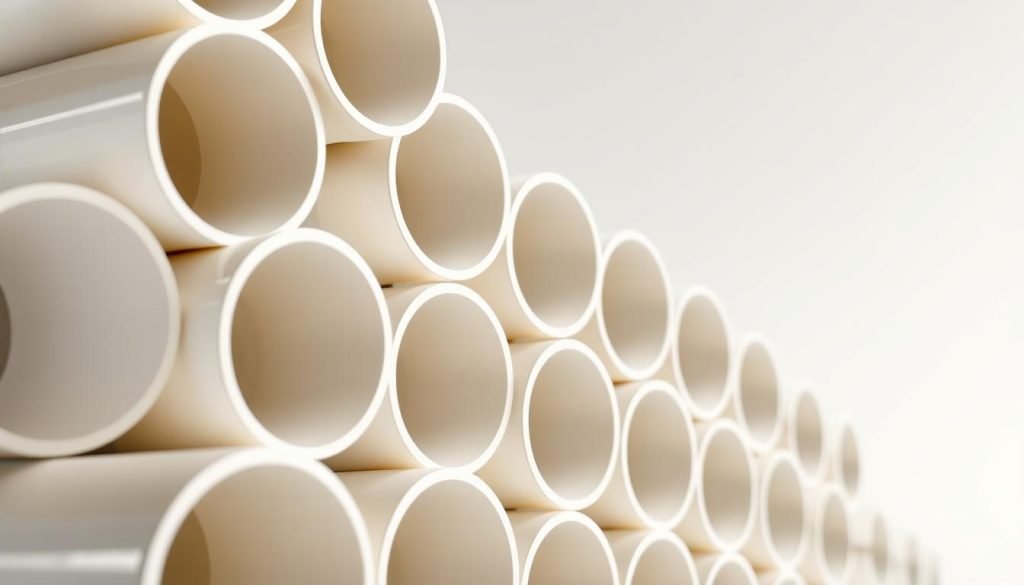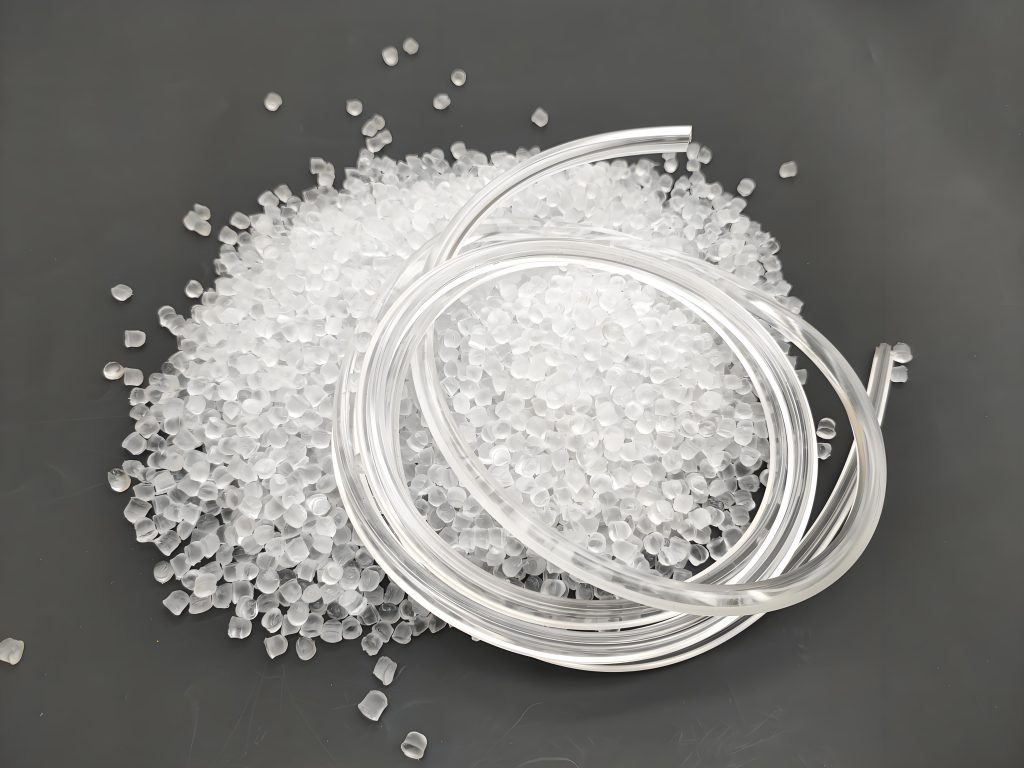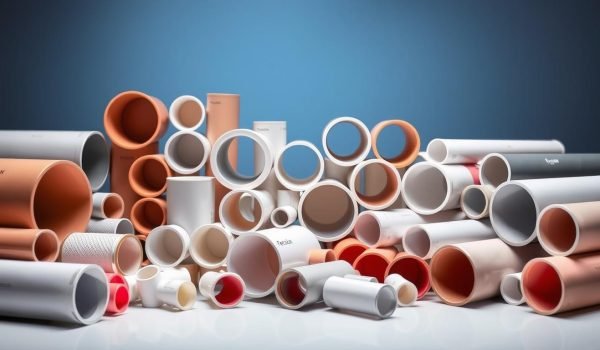Which version of pvc will best save time, money, and headaches on your next project?
You’ll get a clear definition of polyvinyl chloride and a fast look at key properties you can use when choosing pipe for plumbing or site systems.
This introduction previews major groups—rigid, chlorinated, oriented, and modified—so you can spot where each option shines in water, drainage, irrigation, and fuel networks.
Learn how formulation and additives change performance and why strengths like corrosion resistance, light weight, and easy handling deliver many benefits during installation and over a long lifecycle.
By the end of this guide you’ll know which grade to consider first, what pressure and wall specs matter, and how recyclability and safety affect real-world applications.
What Is PVC (Polyvinyl Chloride) and Why You Use It Today
What makes polyvinyl chloride a go-to material for modern piping and profiles is its tunable composition. PVC starts as a resin made by polymerizing vinyl chloride. That base resin is then compounded with stabilizers, lubricants, and other additives to meet specific goals.

How it’s formulated: resin, stabilizers, and optional plasticizers
The compounding process defines whether you get a rigid product for pressure pipe or a flexible grade for conduit and flexible profiles. Add plasticizers to create bendable material; skip them for unplasticized, rigid service used in many pvc pipe systems.
Chlorinated variants increase service temperatures for hot-water lines, while foam-core constructions reduce weight for non-pressurized drainage and vent runs. Your choice of resin family, compound quality, and joining method directly affects longevity, joint integrity, and code compliance.
By understanding structure and formulation, you can match material properties to job demands—stress, temperatures, chemical exposure, and installation practices—so your pipes and fittings perform reliably for decades.
Key Properties of PVC Plastic That Drive Performance
Understanding the core properties helps you choose the right pvc for the demands of your project. These traits tie structure, handling, and service life together so you can design for fewer failures and lower costs.
Strength, stiffness, and impact under pressure
Baseline strength and stiffness let pipes keep shape under load and pressure. Grades like PVC-U and PVC-O offer high mechanical performance that resists deformation.
Some oriented and modified products add impact resistance for handling, backfill, and traffic loads.
Chemical and corrosion resistance
PVC resists many acids, bases, and salts, which makes it a top pick for water and sewer service. Corrosion resistance lowers the need for coatings or cathodic protection in buried systems.
Temperature limits and UV exposure
Standard rigid pvc generally suits warm service up to about 60°C, while chlorinated grades tolerate higher temperatures for hot-water lines. UV is managed with stabilizers or shielding for exposed runs.
Durability, lifespan, and low maintenance
PVC-U can deliver long underground life—reports near 100 years—when installation, pressure rating, and backfill match specs. That durability cuts maintenance and leak risk for buried and above-ground systems.
Types of PVC: PVC-U, C-PVC, PVC-O, and Modified Grades Explained
Start by asking where the pipe will run and what fluid it carries. That helps you pick a grade that balances cost, pressure capacity, and service life.
PVC-U (rigid)
PVC-U is the common choice for drinking water, sewer, drainage, and many site utilities. It is light, affordable, corrosion-resistant, UV-stable, and fully recyclable.
C-PVC (chlorinated)
C‑PVC shares many strengths with rigid grades but works at higher temperatures. Use it for hot and cold water lines where extra heat resistance matters.
PVC-O (oriented)
PVC‑O has layered molecular orientation that raises strength-to-weight, ductility, and hydraulic capacity. It’s ideal for pressure drinking water mains, irrigation, and sewer pumping lines where lower friction saves energy.
Modified family and PVC‑HI
Modified blends like PVC‑M and PVC‑A boost toughness and cut crack growth. That lets you use thinner walls and gain hydraulic advantages in pressured piping.
PVC‑HI meets ISO 6993‑1 for buried gas up to 1 bar and is widely used in natural gas distribution. It offers the impact resistance and long-term strength needed for fuel networks and shows promise for hydrogen service.
Schedules, walls, and real-world picks
Choose Schedule 40 for standard residential pressure work and Schedule 80 where higher pressure demands thicker walls. Foam-core sections work best in non-pressurized DWV runs to cut weight and speed installation.
Match your selection to drinking water or irrigation needs, to sewer and drainage profiles, and to the required pressure class to get the performance and durability your project demands.
Pros and Cons of Rigid & Flexible PVC for Your Project
Your choice between a stiff line and a bendable one changes installation and long-term performance. Consider routing, climate, exposure, and how much movement the ground or equipment will impose.
Rigid PVC (PVC-U, PVC-O): benefits, limitations, and best-fit applications
Rigid pvc offers cost-effective strength and low corrosion for mains, risers, and standard site systems. It is non-toxic for potable water and simple to join, so crews install long runs fast.
Limitations include sensitivity to very low temperatures and UV without protection. PVC-O improves impact and hydraulic performance but keeps similar temperature limits to standard rigid grades.
Processing, Recycling, and Safety: From Manufacturing to End-of-Life

Knowing how polyvinyl chloride is made and handled helps you plan for durable, code-compliant plumbing and long-term reuse.
Extrusion is the main process that forms pipes to precise diameters and smooth bores. Injection molding produces matching fittings so assemblies meet code and perform without leaks.
Recycling and material recovery
PVC-U, C-PVC, and PVC-O streams are routinely recovered. Post-industrial scrap is often reprocessed into new pipe or non-pressurized products.
Modified grades can be mechanically recycled depending on cleanliness. Segregate offcuts and coordinate with processors that accept specific grades to close the loop.
Safe use for drinking water and installation basics
Both PVC-U and C-PVC have broad potable approvals in the U.S. when installed per NSF listings and local code. CPVC handles higher hot water temperatures when needed.
Follow clear installation steps: square and deburr cuts, use the correct primer and solvent cement, allow cure time, and support horizontal runs to prevent sag. Document the work for inspection and warranty.
Energy, distribution, and job closeout
The smooth bore reduces pumping energy across supply and distribution lines. Plan wall thickness—Schedule 40 for standard homes, Schedule 80 for higher pressure—so your system meets service demands.
Conclusion
Use this closing guide to turn material traits into clear choices for your next piping project. PVC is the base resin that, when formulated, gives you rigid, chlorinated, oriented, or modified grades suited to specific applications.
Pick the rigid grade for potable water, sewer, and general drainage. Choose the chlorinated option for hotter supply lines, and the oriented grade for high-performance pressure mains and irrigation. Modified blends add toughness where impact or ductility matters.
Align schedule and wall with your design pressure. Source recyclable products and follow listed fittings and installation steps for code-compliant plumbing and long-term service.
FAQ
Can you use this material for natural gas or hydrogen distribution?
Certain high-impact, gas-certified formulations meet the standards for natural gas networks. Emerging hydrogen-ready grades aim to address permeation and embrittlement concerns. Always follow local codes and third-party certification for fuel gas applications.
What role do pipe schedule and wall thickness play in pressure systems?
Schedule classifications define wall thickness for a given diameter and thus determine pressure rating and stiffness. Heavier walls (higher schedule) increase burst strength and reduce deflection, essential for higher pressure or deep burial conditions.
How is this material processed into pipes and fittings?
Common methods include extrusion for continuous pipe and injection molding for fittings. Orientation, calendering, and co-extrusion create specialized profiles and multi-layer products. Processing parameters affect final strength, surface quality, and joint compatibility.
Is recycling available and how is end-of-life handled?
Yes. Many rigid and chlorinated variants can be reclaimed through mechanical recycling or energy recovery. Collection programs, on-site segregation, and compliant recycling streams support circular use. Reuse depends on contaminant levels and local recycling infrastructure.
Are there health or safety concerns for drinking water installations?
Approved formulations for potable water meet NSF/ANSI and local code requirements to limit leaching and ensure safety. Proper installation, certified fittings, and adherence to pressure and temperature limits help protect water quality and public health.




